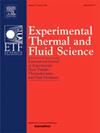Effects of heating orientation on flow boiling in copper manifold microchannel heat sinks
IF 3.3
2区 工程技术
Q2 ENGINEERING, MECHANICAL
Experimental Thermal and Fluid Science
Pub Date : 2025-06-21
DOI:10.1016/j.expthermflusci.2025.111553
引用次数: 0
Abstract
Recently, two-phase cooling configurations are being proposed to meet the power dissipation requirements of high heat flux electronic devices. Flow boiling in Manifold Microchannel (MMC) offers high heat transfer coefficients with low pressure drops, making it a popular choice. While many studies have explored flow boiling in microchannels, the influence of heating orientation in MMCs with complex 3D flow paths has not been investigated thoroughly. In this study, experiments are conducted to investigate the effects of heating orientations and mass flow rates on heat transfer performance, pressure drop, and the hysteresis phenomenon during flow boiling in a copper manifold microchannel heat sink, using the environmentally friendly refrigerant R1233zd(E) as the working fluid. Four heating orientations are studies: Upward Heating (UH), Downward Heating (DH), Horizontal Heating with Vertical Microchannels (HVMC), and Horizontal Heating with Vertical Manifolds (HVMF). The experiments are carried out with mass flow rates between 2.5 and 12.5 g/s, and the inlet subcooling temperature is set to 5 K. The results show that heating orientation significantly affects heat transfer performance, especially at high flow rates and higher heat fluxes. The Horizontal Heating with Vertical Manifolds (HVMF) configuration achieves the best heat transfer performance, while Downward Heating (DH) configuration exhibits the lowest performance. In contrast, heating orientation has a minimal effect on pressure drop performance. An increase in mass flow rate improves the heat transfer performance and raises the pressure drop in manifold microchannel heat sinks. Additionally, hysteresis phenomena are observed in both wall temperature and pressure drop between the heating and cooling curves. A notable wall temperature overshoot occurs before the Onset of Nucleate Boiling (ONB), which decreases with increasing mass flow rate. In the pressure drop curves, hysteresis is also evident, with higher pressure drops during the cooling process compared to the heating process at the same heat flux near ONB. The hysteresis in pressure drop becomes more pronounced at higher mass flow rates.
加热方向对铜流形微通道散热器流动沸腾的影响
近年来,为了满足高热流密度电子器件的功耗要求,提出了两相冷却结构。流动沸腾在流形微通道(MMC)提供高传热系数和低压力降,使其成为一个受欢迎的选择。虽然已有许多研究对微通道内的流动沸腾进行了探索,但对具有复杂三维流道的mmc中加热取向的影响尚未进行深入研究。本研究以环保制冷剂R1233zd(E)为工质,研究了加热方向和质量流量对铜流形微通道散热器传热性能、压降和流动沸腾滞后现象的影响。研究了四种加热方向:向上加热(UH),向下加热(DH),垂直微通道水平加热(HVMC)和垂直歧管水平加热(HVMF)。实验条件为质量流量为2.5 ~ 12.5 g/s,进口过冷温度为5 K。结果表明,加热方向对换热性能有显著影响,特别是在大流量和高热流密度时。垂直管汇水平加热(HVMF)的传热性能最好,而向下加热(DH)的传热性能最差。相反,加热方向对压降性能的影响最小。质量流量的增加改善了传热性能,提高了多管微通道散热器的压降。此外,在加热曲线和冷却曲线之间的壁面温度和压降均存在滞后现象。在成核沸腾发生前,壁温会出现显著的超调,随质量流量的增加而减小。在压降曲线上,滞后性也很明显,在ONB附近相同热流密度下,冷却过程的压降高于加热过程。在较大的质量流量下,压降的滞后性更为明显。
本文章由计算机程序翻译,如有差异,请以英文原文为准。
求助全文
约1分钟内获得全文
求助全文
来源期刊

Experimental Thermal and Fluid Science
工程技术-工程:机械
CiteScore
6.70
自引率
3.10%
发文量
159
审稿时长
34 days
期刊介绍:
Experimental Thermal and Fluid Science provides a forum for research emphasizing experimental work that enhances fundamental understanding of heat transfer, thermodynamics, and fluid mechanics. In addition to the principal areas of research, the journal covers research results in related fields, including combined heat and mass transfer, flows with phase transition, micro- and nano-scale systems, multiphase flow, combustion, radiative transfer, porous media, cryogenics, turbulence, and novel experimental techniques.
 求助内容:
求助内容: 应助结果提醒方式:
应助结果提醒方式:


